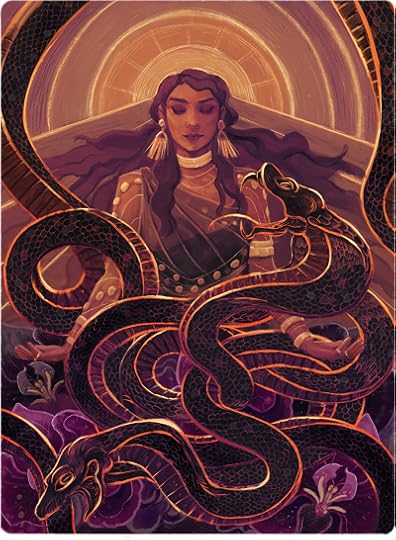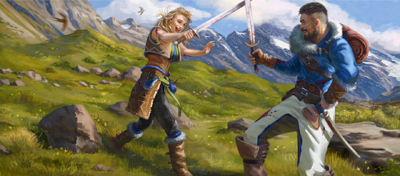Guest Blog: Interview with Suzanne Helmigh on Caldyra
On April 19, Suzanne Helmigh launched a Kickstarter campaign to fund her illustrated fantasy novel Caldyra, the first in a planned trilogy of books. The project was funded in just 27 hours and is now building toward various stretch goals.
I was familiar with Suzanne from her work on Magic: The Gathering. When I saw that she was working on not only a fantasy novel, but a fully illustrated and immersive one, I wanted to learn more about the project.
Hailing from the Netherlands, Suzanne is a professional concept artist and illustrator. She has a degree in film and animation, and had worked on games like Magic: The Gathering and Horizon Zero Dawn. She has a passion for worldbuilding and counts Star Wars, Indiana Jones, and Jurassic Park among her biggest influences.

Pat: As a fellow writer, I’m always interested to hear about an author’s publishing journey. With so many options out there — self-publishing, indie publishing, traditional publishing — why did you decide on Kickstarter as your publishing avenue?
Suzanne: Being an experienced artist, yet fairly new to writing, I am under the impression that most publishers would not take the risk of accepting someone’s first book. I personally feel like, if I can publish it myself and have proof that I have a good story to tell, I can later pitch new stories to other publishers. I’ve actually had some publishers approach me with offers, but they seemed rather outrageous when it came to the revenue I would earn for myself. Kickstarter feels much more personal and keeps me in control.
Pat: You’ve been working on Caldyra for some time, first as an illustration project and then as a full-on narrative story. How did the idea come about?
Suzanne: Caldyra started off as a distraction. I would work normal office hours at a game studio on golf and Candy Crush-like games, which are soul-killing subjects for those who like to create worlds. So, whenever I came home I would slowly build scenes, situations, dialogues, faces, outfits, personalities, mannerisms. Locations, etc. The more I built, the more it turned into a set of four stories, intertwining with one another.
My first few drafts were horrible. I simply started writing with an idea in mind, from beginning to end. Yet, every time I would bump into problems: the story would get stale or boring, or there would be continuity issues. I realized that even though I graduated from film school with a focus on screenplay writing, my actual writing sucked. I became obsessed with learning books about writing fictional stories. One stuck in particular: Randy Ingermanson’s How to Write a Novel Using the Snowflake Method. I recommend it to everyone who writes!

Pat: Can you tell us what “Caldyra” means and how you came up with the term?
Suzanne: Caldyra comes from caldera, which is the word for the formation that results from a lava eruption. So, that circular shape you see in volcanos is called a caldera.
In my book, Caldyra is a deity that consists of two sky wyrms that share a single consciousness. At some point in the legend, one of them crashes down to the earth, creating volcanoes on impact. The volcanoes erupt and devastate the land, after which it prospers by a hundredfold, spawning magical trees. The remainder of people that survived the previous volcanic devastation are now empowered with magical abilities, which they harvest from those trees.
This took place centuries before my book begins. The book itself starts just after a global war on the last remnants of Caldyra trees. People suddenly have to live again without any magical abilities. The age of Caldyra is seen as passed, but not everyone is so keen to give up on it.
Pat: You have a number of guest artists assisting with Caldyra. What role will they play in helping you tell the story?
Suzanne: They will mainly help with the images that I’ll use to open every chapter. In contrast with the rest of my book, where I aim for a realistic cinematic feel, these chapter openers are meant to be symbolic and very artistic.

(One of the chapter openers by guest artist Amagoia Agirre.)
Pat: Writers can be notorious procrastinators (myself included). What has it been like pulling double-duty as writer and artist on this project?
Suzanne: I think my personality traits that come with being a concept artist and illustrator have pushed away the urge to procrastinate. I used to procrastinate a lot actually, before this project. But I turned my thoughts towards becoming my own drill sergeant and am much more likely to work myself to death than to wait things out.
I’ve spent years working 16 hours a day for both clients and my own projects, to an extent where I find it pretty hard to relax and enjoy the sun or a game. I always try and find tasks that I consider hard. Writing is hard because I have a strong case of dyslexia (but don’t worry, I’ve created my book in collaboration with an editor). Painting crazy staircases: hard? Let’s make two. Painting crowds of people: hard? Yup, let’s make at least three of those!
Pat: I’d like to pivot for a moment to your work on Magic: The Gathering. You recently joined the MTG art community and provided art for the last two sets. How did you get started with Magic?
Suzanne: It’s a funny story. There’s an art website called Deviantart, where I have my roots like many other artists. On that website people know me less for my art than for my artist blog posts, which can get more than 300,000 unique reads. One blog post in particular was about my ambition to work on Magic: The Gathering and my three-year plan to work on my portfolio in order to make it happen.
One of the art directors back then (already in 2016) read that post and actually contacted me right after, giving me feedback and inviting me to mail him updates of my progress. Half a year later, after a few back and forths, I received the email I had been dreaming of: “Suzanne, welcome to the Magic artist team!”
It’s fair to say I did a couple of silly dances in my office and celebrated by eating cake.
Pat: What has been your favorite card to work on so far?
Suzanne: My favorite card has not been released yet, as all these sets get commissioned a bit more than a year in advance! But my favorite one that is out must be Radiating Lightning. I am a sucker for painting groups of people, especially where I can work on their body language and facial expressions.
My favorite card to play with that I worked on is by far is Rat Colony. Oooh how I’m going to wreck some fields with that!

(Radiating Lightning for Magic: The Gathering.)
Pat: I always love hearing that MTG artists also enjoy the game themselves! What formats do you play?
Suzanne: I love EDH, drafting whenever there is a new set, cube (we own a fantastic one, with a custom-made wooden box!), and just homebrew.
Pat: And will fans continue to see your work in future Magic sets? How about any other games you’re currently working on?
Suzanne: Yes! I am still doing some Magic cards here and there. I have also done some work for a new card game called Artifact that Valve is releasing, as have many other MTG artists. [Author’s note: Artifact was designed by Magic: The Gathering creator Richard Garfield and is expected to release sometime this year.]
Pat: Finally, I know you have an interest in Historical European Martial Arts, also known as HEMA. Will you be serving as a fight coordinator when the inevitable Caldyra film adaptation occurs?
Suzanne: Hahaha, I think that job is far better suited to some crazy cool martial arts choreographers in Hollywood. Not that I even dare dream of a film adaptation of my story!
Funny enough, fighting in movies is never ever accurate in the slightest. That is because they use impractical moves that look cool and big, but that make you incredibly slow. The HEMA group I train with is also specialized in show-fighting, so we learn to do both and spot the difference!
To learn more about Caldyra, back the campaign, or read a sample chapter, visit caldyra.com.

I was familiar with Suzanne from her work on Magic: The Gathering. When I saw that she was working on not only a fantasy novel, but a fully illustrated and immersive one, I wanted to learn more about the project.
Hailing from the Netherlands, Suzanne is a professional concept artist and illustrator. She has a degree in film and animation, and had worked on games like Magic: The Gathering and Horizon Zero Dawn. She has a passion for worldbuilding and counts Star Wars, Indiana Jones, and Jurassic Park among her biggest influences.

Pat: As a fellow writer, I’m always interested to hear about an author’s publishing journey. With so many options out there — self-publishing, indie publishing, traditional publishing — why did you decide on Kickstarter as your publishing avenue?
Suzanne: Being an experienced artist, yet fairly new to writing, I am under the impression that most publishers would not take the risk of accepting someone’s first book. I personally feel like, if I can publish it myself and have proof that I have a good story to tell, I can later pitch new stories to other publishers. I’ve actually had some publishers approach me with offers, but they seemed rather outrageous when it came to the revenue I would earn for myself. Kickstarter feels much more personal and keeps me in control.
Pat: You’ve been working on Caldyra for some time, first as an illustration project and then as a full-on narrative story. How did the idea come about?
Suzanne: Caldyra started off as a distraction. I would work normal office hours at a game studio on golf and Candy Crush-like games, which are soul-killing subjects for those who like to create worlds. So, whenever I came home I would slowly build scenes, situations, dialogues, faces, outfits, personalities, mannerisms. Locations, etc. The more I built, the more it turned into a set of four stories, intertwining with one another.
My first few drafts were horrible. I simply started writing with an idea in mind, from beginning to end. Yet, every time I would bump into problems: the story would get stale or boring, or there would be continuity issues. I realized that even though I graduated from film school with a focus on screenplay writing, my actual writing sucked. I became obsessed with learning books about writing fictional stories. One stuck in particular: Randy Ingermanson’s How to Write a Novel Using the Snowflake Method. I recommend it to everyone who writes!

Pat: Can you tell us what “Caldyra” means and how you came up with the term?
Suzanne: Caldyra comes from caldera, which is the word for the formation that results from a lava eruption. So, that circular shape you see in volcanos is called a caldera.
In my book, Caldyra is a deity that consists of two sky wyrms that share a single consciousness. At some point in the legend, one of them crashes down to the earth, creating volcanoes on impact. The volcanoes erupt and devastate the land, after which it prospers by a hundredfold, spawning magical trees. The remainder of people that survived the previous volcanic devastation are now empowered with magical abilities, which they harvest from those trees.
This took place centuries before my book begins. The book itself starts just after a global war on the last remnants of Caldyra trees. People suddenly have to live again without any magical abilities. The age of Caldyra is seen as passed, but not everyone is so keen to give up on it.
Pat: You have a number of guest artists assisting with Caldyra. What role will they play in helping you tell the story?
Suzanne: They will mainly help with the images that I’ll use to open every chapter. In contrast with the rest of my book, where I aim for a realistic cinematic feel, these chapter openers are meant to be symbolic and very artistic.

(One of the chapter openers by guest artist Amagoia Agirre.)
Pat: Writers can be notorious procrastinators (myself included). What has it been like pulling double-duty as writer and artist on this project?
Suzanne: I think my personality traits that come with being a concept artist and illustrator have pushed away the urge to procrastinate. I used to procrastinate a lot actually, before this project. But I turned my thoughts towards becoming my own drill sergeant and am much more likely to work myself to death than to wait things out.
I’ve spent years working 16 hours a day for both clients and my own projects, to an extent where I find it pretty hard to relax and enjoy the sun or a game. I always try and find tasks that I consider hard. Writing is hard because I have a strong case of dyslexia (but don’t worry, I’ve created my book in collaboration with an editor). Painting crazy staircases: hard? Let’s make two. Painting crowds of people: hard? Yup, let’s make at least three of those!
Pat: I’d like to pivot for a moment to your work on Magic: The Gathering. You recently joined the MTG art community and provided art for the last two sets. How did you get started with Magic?
Suzanne: It’s a funny story. There’s an art website called Deviantart, where I have my roots like many other artists. On that website people know me less for my art than for my artist blog posts, which can get more than 300,000 unique reads. One blog post in particular was about my ambition to work on Magic: The Gathering and my three-year plan to work on my portfolio in order to make it happen.
One of the art directors back then (already in 2016) read that post and actually contacted me right after, giving me feedback and inviting me to mail him updates of my progress. Half a year later, after a few back and forths, I received the email I had been dreaming of: “Suzanne, welcome to the Magic artist team!”
It’s fair to say I did a couple of silly dances in my office and celebrated by eating cake.
Pat: What has been your favorite card to work on so far?
Suzanne: My favorite card has not been released yet, as all these sets get commissioned a bit more than a year in advance! But my favorite one that is out must be Radiating Lightning. I am a sucker for painting groups of people, especially where I can work on their body language and facial expressions.
My favorite card to play with that I worked on is by far is Rat Colony. Oooh how I’m going to wreck some fields with that!

(Radiating Lightning for Magic: The Gathering.)
Pat: I always love hearing that MTG artists also enjoy the game themselves! What formats do you play?
Suzanne: I love EDH, drafting whenever there is a new set, cube (we own a fantastic one, with a custom-made wooden box!), and just homebrew.
Pat: And will fans continue to see your work in future Magic sets? How about any other games you’re currently working on?
Suzanne: Yes! I am still doing some Magic cards here and there. I have also done some work for a new card game called Artifact that Valve is releasing, as have many other MTG artists. [Author’s note: Artifact was designed by Magic: The Gathering creator Richard Garfield and is expected to release sometime this year.]
Pat: Finally, I know you have an interest in Historical European Martial Arts, also known as HEMA. Will you be serving as a fight coordinator when the inevitable Caldyra film adaptation occurs?
Suzanne: Hahaha, I think that job is far better suited to some crazy cool martial arts choreographers in Hollywood. Not that I even dare dream of a film adaptation of my story!
Funny enough, fighting in movies is never ever accurate in the slightest. That is because they use impractical moves that look cool and big, but that make you incredibly slow. The HEMA group I train with is also specialized in show-fighting, so we learn to do both and spot the difference!
To learn more about Caldyra, back the campaign, or read a sample chapter, visit caldyra.com.

Published on May 06, 2018 18:09
•
Tags:
art, author-interview, books, fantasy, illustration, interview, publishing
No comments have been added yet.



